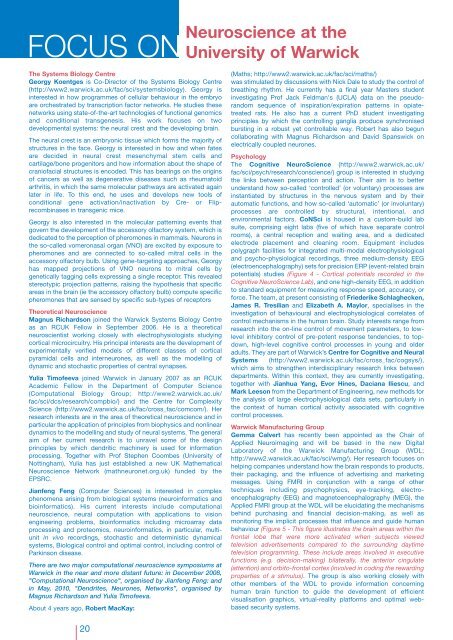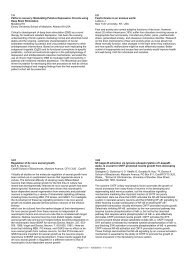Thalamostriatal projections revisited - British Neuroscience ...
Thalamostriatal projections revisited - British Neuroscience ...
Thalamostriatal projections revisited - British Neuroscience ...
- No tags were found...
You also want an ePaper? Increase the reach of your titles
YUMPU automatically turns print PDFs into web optimized ePapers that Google loves.
FOCUS ON<strong>Neuroscience</strong> at theUniversity of WarwickThe Systems Biology CentreGeorgy Koentges is Co-Director of the Systems Biology Centre(http://www2.warwick.ac.uk/fac/sci/systemsbiology). Georgy isinterested in how programmes of cellular behaviour in the embryoare orchestrated by transcription factor networks. He studies thesenetworks using state-of-the-art technologies of functional genomicsand conditional transgenesis. His work focuses on twodevelopmental systems: the neural crest and the developing brain.The neural crest is an embryonic tissue which forms the majority ofstructures in the face. Georgy is interested in how and when fatesare decided in neural crest mesenchymal stem cells andcartilage/bone progenitors and how information about the shape ofcraniofacial structures is encoded. This has bearings on the originsof cancers as well as degenerative diseases such as rheumatoidarthritis, in which the same molecular pathways are activated againlater in life. To this end, he uses and develops new tools ofconditional gene activation/inactivation by Cre- or Fliprecombinasesin transgenic mice.Georgy is also interested in the molecular patterning events thatgovern the development of the accessory olfactory system, which isdedicated to the perception of pheromones in mammals. Neurons inthe so-called vomeronasal organ (VNO) are excited by exposure topheromones and are connected to so-called mitral cells in theaccessory olfactory bulb. Using gene-targeting approaches, Georgyhas mapped <strong>projections</strong> of VNO neurons to mitral cells bygenetically tagging cells expressing a single receptor. This revealedstereotypic projection patterns, raising the hypothesis that specificareas in the brain (ie the accessory olfactory bulb) compute specificpheromones that are sensed by specific sub-types of receptorsTheoretical <strong>Neuroscience</strong>Magnus Richardson joined the Warwick Systems Biology Centreas an RCUK Fellow in September 2006. He is a theoreticalneuroscientist working closely with electrophysiologists studyingcortical microcircuitry. His principal interests are the development ofexperimentally verified models of different classes of corticalpyramidal cells and interneurones, as well as the modelling ofdynamic and stochastic properties of central synapses.Yulia Timofeeva joined Warwick in January 2007 as an RCUKAcademic Fellow in the Department of Computer Science(Computational Biology Group; http://www2.warwick.ac.uk/fac/sci/dcs/research/compbio/) and the Centre for ComplexityScience (http://www2.warwick.ac.uk/fac/cross_fac/comcom/). Herresearch interests are in the area of theoretical neuroscience and inparticular the application of principles from biophysics and nonlineardynamics to the modelling and study of neural systems. The generalaim of her current research is to unravel some of the designprinciples by which dendritic machinery is used for informationprocessing. Together with Prof Stephen Coombes (University ofNottingham), Yulia has just established a new UK Mathematical<strong>Neuroscience</strong> Network (mathneuronet.org.uk) funded by theEPSRC.Jianfeng Feng (Computer Sciences) is interested in complexphenomena arising from biological systems (neuroinformatics andbioinformatics). His current interests include computationalneuroscience, neural computation with applications to visionengineering problems, bioinformatics including microarray dataprocessing and proteomics, neuroinformatics, in particular, multiunitin vivo recordings, stochastic and deterministic dynamicalsystems, Biological control and optimal control, including control ofParkinson disease.There are two major computational neuroscience symposiums atWarwick in the near and more distant future: in December 2008,"Computational <strong>Neuroscience</strong>", organised by Jianfeng Feng: andin May, 2010, "Dendrites, Neurones, Networks”, organised byMagnus Richardson and Yulia Timofeeva.About 4 years ago, Robert MacKay:(Maths; http://www2.warwick.ac.uk/fac/sci/maths/)was stimulated by discussions with Nick Dale to study the control ofbreathing rhythm. He currently has a final year Masters studentinvestigating Prof Jack Feldman's (UCLA) data on the pseudorandomsequence of inspiration/expiration patterns in opiatetreatedrats. He also has a current PhD student investigatingprinciples by which the controlling ganglia produce synchronisedbursting in a robust yet controllable way. Robert has also beguncollaborating with Magnus Richardson and David Spanswick onelectrically coupled neurones.PsychologyThe Cognitive NeuroScience (http://www2.warwick.ac.uk/fac/sci/psych/research/conscience/) group is interested in studyingthe links between perception and action. Their aim is to betterunderstand how so-called ‘controlled’ (or voluntary) processes areinstantiated by structures in the nervous system and by theirautomatic functions, and how so-called ‘automatic’ (or involuntary)processes are controlled by structural, intentional, andenvironmental factors. CoNSci is housed in a custom-build labsuite, comprising eight labs (five of which have separate controlrooms), a central reception and waiting area, and a dedicatedelectrode placement and cleaning room. Equipment includespolygraph facilities for integrated multi-modal electrophysiologicaland psycho-physiological recordings, three medium-density EEG(electroencephalography) sets for precision ERP (event-related brainpotentials) studies (Figure 4 - Cortical potentials recorded in theCognitive NeuroScience Lab), and one high-density EEG, in additionto standard equipment for measuring response speed, accuracy, orforce. The team, at present consisting of Friederike Schlaghecken,James R. Tresilian and Elizabeth A. Maylor, specialises in theinvestigation of behavioural and electrophysiological correlates ofcontrol mechanisms in the human brain. Study interests range fromresearch into the on-line control of movement parameters, to lowlevelinhibitory control of pre-potent response tendencies, to topdown,high-level cognitive control processes in young and olderadults. They are part of Warwick’s Centre for Cognitive and NeuralSystems (http://www2.warwick.ac.uk/fac/cross_fac/cogsys/),which aims to strengthen interdisciplinary research links betweendepartments. Within this context, they are currently investigating,together with Jianhua Yang, Evor Hines, Daciana Iliescu, andMark Leeson from the Department of Engineering, new methods forthe analysis of large electrophysiological data sets, particularly inthe context of human cortical activity associated with cognitivecontrol processes.Warwick Manufacturing GroupGemma Calvert has recently been appointed as the Chair ofApplied Neuroimaging and will be based in the new DigitalLaboratory of the Warwick Manufacturing Group (WDL;http://www2.warwick.ac.uk/fac/sci/wmg/). Her research focuses onhelping companies understand how the brain responds to products,their packaging, and the influence of advertising and marketingmessages. Using FMRI in conjunction with a range of othertechniques including psychophysics, eye-tracking, electroencephalography(EEG) and magnetoencephalography (MEG), theApplied FMRI group at the WDL will be elucidating the mechanismsbehind purchasing and financial decision-making, as well asmonitoring the implicit processes that influence and guide humanbehaviour (Figure 5 - This figure illustrates the brain areas within thefrontal lobe that were more activated when subjects viewedtelevision advertisements compared to the surrounding daytimetelevision programming. These include areas involved in executivefunctions (e.g. decision-making) bilaterally, the anterior cingulate(attention) and orbito-frontal cortex (involved in coding the rewardingproperties of a stimulus). The group is also working closely withother members of the WDL to provide information concerninghuman brain function to guide the development of efficientvisualisation graphics, virtual-reality platforms and optimal webbasedsecurity systems.20
















